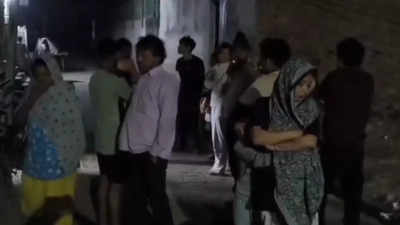- News
- India News
- 4.0 magnitude earthquake hits Delhi-NCR, strong tremors felt across north India
Trending
4.0 magnitude earthquake hits Delhi-NCR, strong tremors felt across north India
NEW DELHI: New Delhi and several parts of northern India were shaken by strong earthquake tremors early Monday morning. The strong tremors caused residents of high-rise buildings in Delhi, Noida, Greater Noida, and Ghaziabad to rush out of their homes.
The tremor occurred at 5:36 am, with its epicentre located near Durgabai Deshmukh College of Special Education in Dhaula Kuan at a depth of five kilometres, officials confirmed. There were no immediate reports of any damage or injuries.
The area experiences minor seismic activity every two to three years, with a previous 3.3 magnitude earthquake recorded in 2015. Officials noted that a loud sound accompanied the tremor.
Former Delhi CM Arvind Kejriwal reacted to the strong tremors in Delhi-NCR, posting on X: "I pray for everyone's safety."
In a post on X, The Delhi Police said, "We hope you all are safe, Delhi!"
At New Delhi railway station, a vendor Anish said, "Everything was shaking...customers started screaming."
A passenger waiting for his train at New Delhi railway station described the experience: "I was in the waiting lounge when everyone rushed out. It felt like a bridge or something had collapsed."
Earlier on January 23, Delhi-NCR experienced strong tremors after a 7.2-magnitude earthquake hit Xinjiang, China, at a depth of 80 kilometers.
This followed mild tremors on January 11, when a 6.1-magnitude earthquake struck Afghanistan, shaking the region.
Also read: PM Modi urges to stay calm after 4.0 magnitude strikes Delhi
Delhi, situated 250 kilometres from the seismically-active Himalayan collision zone, regularly experiences seismic activity from both Himalayan and local sources.
Previous significant tremors include a 3.5-magnitude quake on April 12, 2020, a 3.4-magnitude on May 10, 2020, in northeast Delhi, and a 4.4-magnitude earthquake near Rohtak on May 29, 2020, followed by numerous aftershocks.
Being in Seismic Zone IV of India's seismic zoning map, this intraplate region faces moderate to high risk from Himalayan earthquakes.
(This is a developing story)
End of Article
FOLLOW US ON SOCIAL MEDIA











